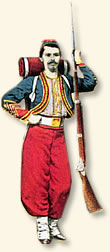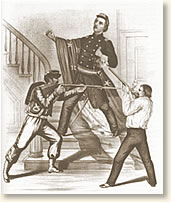|
An Early Casualty of
the Civil War, 1861
Elmer Ellsworth was a hero in the North even before
the first shots of the Civil War. Born in Saratoga Springs, NY, Ellsworth moved
to Chicago to study law. It was here that Ellsworth was introduced to the Zouaves
- colorful military units outfitted in pantalooned uniforms based on those worn
by French colonial troops in Algeria. Ellsworth formed his own Zouave unit and
molded it into a crack drill team.

A Zouave
Click image for
more information
|
In the summer of 1860, Ellsworth and his Zouaves toured the North performing
precision drills before awed audiences in 20 cities. At the end of the summer,
Ellsworth joined Abraham Lincoln's law practice in Springfield, IL as a law clerk.
Impressed with his hard-working, enthusiastic clerk, Lincoln invited Ellsworth
to join his campaign for president. Following his victory, Lincoln asked Ellsworth
to join him in Washington.
As tensions between the North and South states intensified, Ellsworth moved to
New York City. He formed a Zouave unit made up of volunteers from among the
city's firemen - the New York Fire Zouaves - and became its colonel.
May 1861 found Ellsworth and his Zouaves stationed in Washington, DC. On the
23rd of that month the Virginia legislature voted to secede from the Union.
Before the sun rose the next morning, Ellsworth, anxious to see some action,
led his Zouaves across the Potomac River as part of an eleven-regiment Union
invasion of Virginia. Ellsworth's objective was to secure the port of Alexandria.
The Zouave's landing at Alexandria was uncontested, and they quickly spread through
the town securing important targets such as the telegraph office and rail station.
As Ellsworth led his men through the streets his eye caught sight of a Confederate
flag waving from the top of the Marshall House Inn. Followed by four of his
men, Ellsworth rushed into the building, ran up its stairs and cut down the
offensive symbol. Descending the stairs, Ellsworth was confronted by the inn's
proprietor, James W. Jackson, armed with a double-barrel shotgun. Firing at
point-blank range, the inn keeper ended the life of the twenty-four-year-old
and conferred upon him the distinction of being the first Union officer killed in the war. Almost instantaneously, Jackson was cut down by Ellsworth's men.
Grief stricken, Lincoln ordered that Ellsworth's body lay in state at the White House before being returned to New York. Both Ellsworth and Jackson became martyrs to their respective causes. Recruitment of new enlistees increased dramatically on both sides as a result of their deaths
The New York Times carried a vivid description on its front page on the following day:

A contemporary illustration
of the death of Col. Ellsworth
|
"The Zouaves landed in good order in double quick time, each company forming in company order on the street facing the river. . . Col. Ellsworth and his detachment proceeded in double quick time up the street. They had proceeded three blocks, when the attention of Colonel Ellsworth was attracted by a large secession flag flying from the Marshall House, kept by J. W. Jackson. Col. Ellsworth entered the hotel, and seeing a man in the hall asked, 'Who put that flag up?' The man answered, 'I don't know; I am a boarder here.' Col. Ellsworth, Lieut. Winser, the chaplain of the regiment, Mr. House, a volunteer aide, and the four privates, went up to the roof and Col. Ellsworth cut down the flag.
The party were [sic] returning down the stairs, preceded by Private Francis E. Brownell, of Company A. As they left the attic, the man who had said he was a boarder, but proved to be the landlord, Jackson, was met in the hall, having a double-barrel gun, which he leveled at Brownell. Brownell struck up the gun with his musket, when Jackson pulled both triggers of the gun. The contents lodged in the body of Col. Ellsworth, entering between the third and fifth ribs. Col. Ellsworth at the time was rolling up the flag. He fell forward on the floor of the hall and expired instantly, only exclaiming 'My God.'
Private Brownell, with the quickness of lightning, leveled his musket at Jackson and fired. The ball struck Jackson on the bridge of the nose, and crashed through his skull, killing him instantly. As he fell Brownell followed his shot by a thrust of his bayonet which went through Jackson's body."
References:
This account appears in: Gallman, J. Matthew (ed.), The Civil War Chronicle (2000); Randall, Ruth Painter, Colonel Elmer Ellsworth: A biography of Lincoln's friend and first hero of the Civil War, (1960).
How To Cite This Article:
"An Early Casualty of the Civil War, 1861" EyeWitness to History, www.eyewitnesstohistory.com (2008).
|






